Unsteady Lifting-Line Free-Wake Aerodynamic Modeling for Rotors in Hovering and Axial Flight
Abstract
1. Introduction
2. ULLT Formulation for Rotary Wings
2.1. Time-Domain Sectional Loads from Küssner–Schwarz’s Theory
2.2. Linking Bound Circulation to Lift: Unsteady Kutta–Joukowski Theorem
2.3. Inclusion of Three-Dimensional Effects
2.4. Time-Marching Scheme
2.5. Extension to Rotary Wing Applications
3. Numerical Results
3.1. Hovering Steady Flight and Convergence Analysis
3.2. Hovering Rotor with Harmonically Pitching Blades
3.3. Hovering Rotor with Harmonically Flapping Blades
3.4. Free-Wake Analysis
3.5. Inflow Velocity Defect
3.6. Axial Flight
4. Conclusions
Author Contributions
Funding
Data Availability Statement
Conflicts of Interest
Nomenclature
| Symbols | |
| matrices of the non-circulatory part of the generalized aerodynamic loads | |
| Küssner-Schwarz pressure coefficients | |
| semi-chord and chord lengths, m | |
| Theodorsen (lift deficiency) function | |
| coefficients of rational approximation | |
| lift force, N | |
| generalized aerodynamic loads and relative vector | |
| vectors of circulatory part of generalized aerodynamic loads | |
| reciprocal of the Kutta–Joukowski frequency response function | |
| k | reduced frequency |
| L | defect region length, m |
| M | number of modes |
| N | number of Küssner-Schwarz coefficients |
| Küssner-Schwarz downwash coefficients | |
| poles of the rational approximation | |
| Q | rotor torque, Nm |
| Lagrangian coordinates and relative vector | |
| R | rotor radius, m |
| r | additional aerodynamic state, or radial position, m |
| T | rotor thrust, N |
| vector of the non-circulatory part of the generalized aerodynamic loads due to the induced velocity | |
| t | dimensional time, s |
| V | unperturbed flow velocity, m/s |
| v | downwash distribution, m/s |
| induced velocity, m/s | |
| w | vertical displacement, m |
| zeroes of the rational approximation | |
| bound circulation, m2/s | |
| pressure jump distribution, N/m2 | |
| polar nondimensional chordwise coordinate | |
| linear twist distribution, deg/m | |
| nondimensional chordwise coordinate | |
| air density, kg/m3 | |
| nondimensional time | |
| set of shape functions | |
| rotor azimuthal position, rad | |
| rotor angular speed, rad/s | |
| angular frequency, rad/s | |
| Apices | |
| c | circulatory part |
| H | relative to the rational approximation of |
| non-circulatory part | |
| Abbreviations | |
| BEM | Boundary Element Method |
| CFD | Computational Fluid Dynamics |
| LLPG | Lifting-Line Theory Prandtl-Glauert |
| LLT | Lifting-Line Theory |
| ULLT | Unsteady Lifting-Line Theory |
| ULLT-TH | Unsteady Lifting-Line Theory - Theodorsen |
References
- Prandtl, L. Applications of Modern Hydrodynamics to Aeronautics; NACA TR-116. 1923. Available online: https://ntrs.nasa.gov/api/citations/19930091180/downloads/19930091180.pdf (accessed on 1 October 2025).
- Weissinger, J. The Lift Distribution of Swept-Back Wings; NACA TM-1120. 1947. Available online: https://ntrs.nasa.gov/api/citations/20030064148/downloads/20030064148.pdf (accessed on 1 October 2025).
- Prössdorf, S.; Tordella, D. On an extension of Prandti’s lifting line theory to curved wings. IMPACT Comput. Sci. Eng. 1991, 3, 192–212. [Google Scholar] [CrossRef]
- Phillips, W.F.; Snyder, D.O. Modern Adaptation of Prandtl’s Classic Lifting-Line Theory. J. Aircr. 2000, 37, 662–670. [Google Scholar] [CrossRef]
- Sclavounos, P.D. An unsteady lifting-line theory. J. Eng. Math. 1987, 21, 201–226. [Google Scholar] [CrossRef]
- Chiocchia, G.; Tordella, D.; Prössdorf, S. The Lifting Line Equation for a Curved Wing in Oscillatory Motion. ZAMM—J. Appl. Math. Mech./Z. Angew. Math. Mech. 1997, 77, 295–315. [Google Scholar] [CrossRef]
- Drela, M. Integrated simulation model for preliminary aerodynamic, structural, and control-law design of aircraft. In Proceedings of the 40th Structures, Structural Dynamics, and Materials Conference and Exhibit, St. Louis, MO, USA, 12–15 April 1999; p. 1394. [Google Scholar] [CrossRef]
- Sugar-Gabor, O. A general numerical unsteady non-linear lifting line model for engineering aerodynamics studies. Aeronaut. J. 2018, 122, 1199–1228. [Google Scholar] [CrossRef]
- Boutet, J.; Dimitriadis, G. Unsteady Lifting Line Theory Using the Wagner Function for the Aerodynamic and Aeroelastic Modeling of 3D Wings. Aerospace 2018, 5, 92. [Google Scholar] [CrossRef]
- Izraelevitz, J.S.; Zhu, Q.; Triantafyllou, M.S. State-Space Adaptation of Unsteady Lifting Line Theory: Twisting/Flapping Wings of Finite Span. AIAA J. 2017, 55, 1279–1294. [Google Scholar] [CrossRef]
- Bird, H.J.A.; Ramesh, K. Unsteady Lifting-Line Theory and the Influence of Wake Vorticity on Aerodynamic Loads. Theor. Comput. Fluid Dyn. 2021, 35, 609–631. [Google Scholar] [CrossRef]
- Yannic Beyer, Y.; Ullah, J.; Steen, M.; Hecker, P. Unsteady Nonlinear Lifting Line Model for Active Gust Load Alleviation of Airplanes. CEAS Aeronaut. J. 2024, 15, 917–932. [Google Scholar] [CrossRef]
- Goates, C.D.; Hunsaker, D.F. Modern Implementation and Evaluation of Lifting-Line Theory for Complex Geometries. J. Aircr. 2023, 60, 490–508. [Google Scholar] [CrossRef]
- Theodorsen, T. General Theory of Aerodynamic Instability and the Mechanism of Flutter; NACA TR-496. 1935. Available online: https://ntrs.nasa.gov/api/citations/19800006788/downloads/19800006788.pdf (accessed on 1 October 2025).
- Wagner, H. Über die Entstehung des dynamischen Auftriebes von Tragflügeln. ZAMM—J. Appl. Math. Mech./Z. Angew. Math. Mech. 1925, 5, 17–35. [Google Scholar] [CrossRef]
- Giansante, R.; Bernardini, G.; Gennaretti, M. Unsteady Lifting-Line Theory for Camber Morphing Wings State-Space Aeroelastic Modeling. AIAA J. 2024, 62, 4654–4664. [Google Scholar] [CrossRef]
- Frassoldati, G.; Giansante, R.; Bernardini, G.; Gennaretti, M. Unsteady Lifting-Line Free-Wake Aerodynamic Modeling for Morphing Wings. Aerospace 2024, 11, 745. [Google Scholar] [CrossRef]
- Gennaretti, M.; Giansante, R. Kutta–Joukowski Theorem for Unsteady Linear Aerodynamics. AIAA J. 2022, 60, 5779–5790. [Google Scholar] [CrossRef]
- Gennaretti, M.; Luceri, L.; Morino, L. A Unified Boundary Integral Methodology for Aerodynamics and Aeroacoustics of Rotors. J. Sound Vib. 1997, 200, 467–489. [Google Scholar] [CrossRef]
- Sears, W.R. Some Aspects of Non-Stationary Airfoil Theory and Its Practical Application. J. Aeronaut. Sci. 1941, 8, 104–108. [Google Scholar] [CrossRef]
- Giesing, J.; Rodden, W.; Stahl, B. Sears Function and Lifting Surface Theory for Harmonic Gust Fields. J. Aircr. 1970, 7, 252–255. [Google Scholar] [CrossRef]
- Küssner, H.G. Summary Report on the Nonstationary Lift of Wings. Luftfahrtforschung 1936, 13, 410–424. (In German) [Google Scholar]
- Küssner, H.; Schwarz, I. The Oscillating Wing with Aerodynamically Balanced Elevator; NACA TR-991. 1941. Available online: https://ntrs.nasa.gov/api/citations/19930094383/downloads/19930094383.pdf (accessed on 1 October 2025).
- Fung, Y. An Introduction to the Theory of Aeroelasticity; Dover Publications, Inc.: New York, NY, USA, 1993. [Google Scholar]
- Venkatesan, C.; Friedmann, P.P. New Approach to Finite-State Modeling of Unsteady Aerodynamics. AIAA J. 1986, 24, 1889–1897. [Google Scholar] [CrossRef]
- Katz, J.; Plotkin, A. Low-Speed Aerodynamics, 2nd ed.; Cambridge Aerospace Series; Cambridge University Press: Cambridge, UK, 2001. [Google Scholar] [CrossRef]
- Jones, R. Operational Treatment of the Nonuniform-Lift Theory to Airplane Dynamics; NACA TN-667. 1938. Available online: https://ntrs.nasa.gov/api/citations/19930081472/downloads/19930081472.pdf (accessed on 1 October 2025).
- Peters, D.A. Two-Dimensional Incompressible Unsteady Airfoil Theory—An Overview. J. Fluids Struct. 2008, 24, 295–312. [Google Scholar] [CrossRef]
- Gennaretti, M. Fundamentals of Aeroelasticity; Springer Nature: Cham, Switzerland, 2024. [Google Scholar] [CrossRef]
- Heller, H.; Splettstoesser, W.; Kloeppel, V.; Cenedese, F. HELINOISE—The European Community Rotor Acoustics Research Program. AIAA J. 1993. [Google Scholar] [CrossRef]

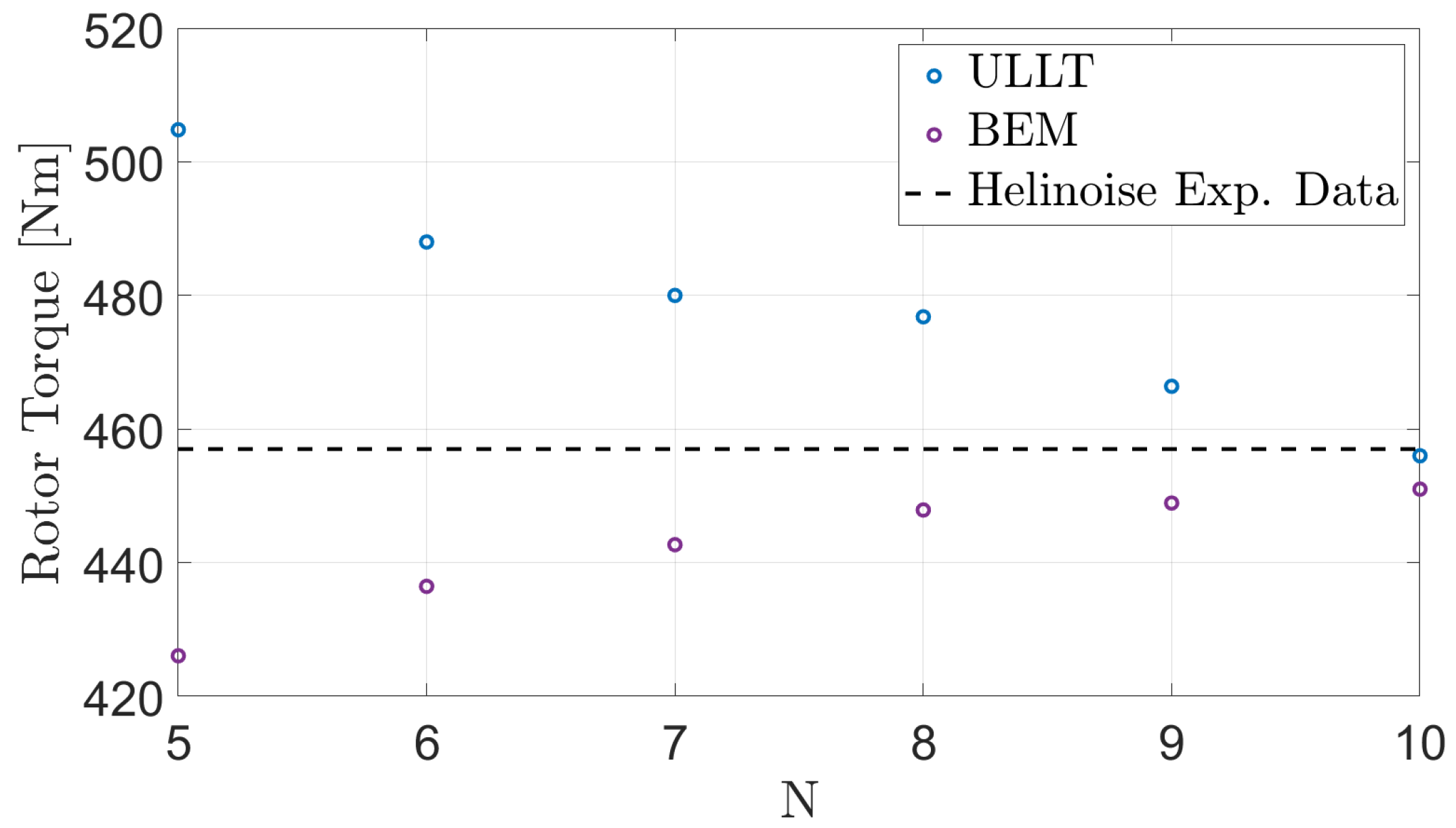


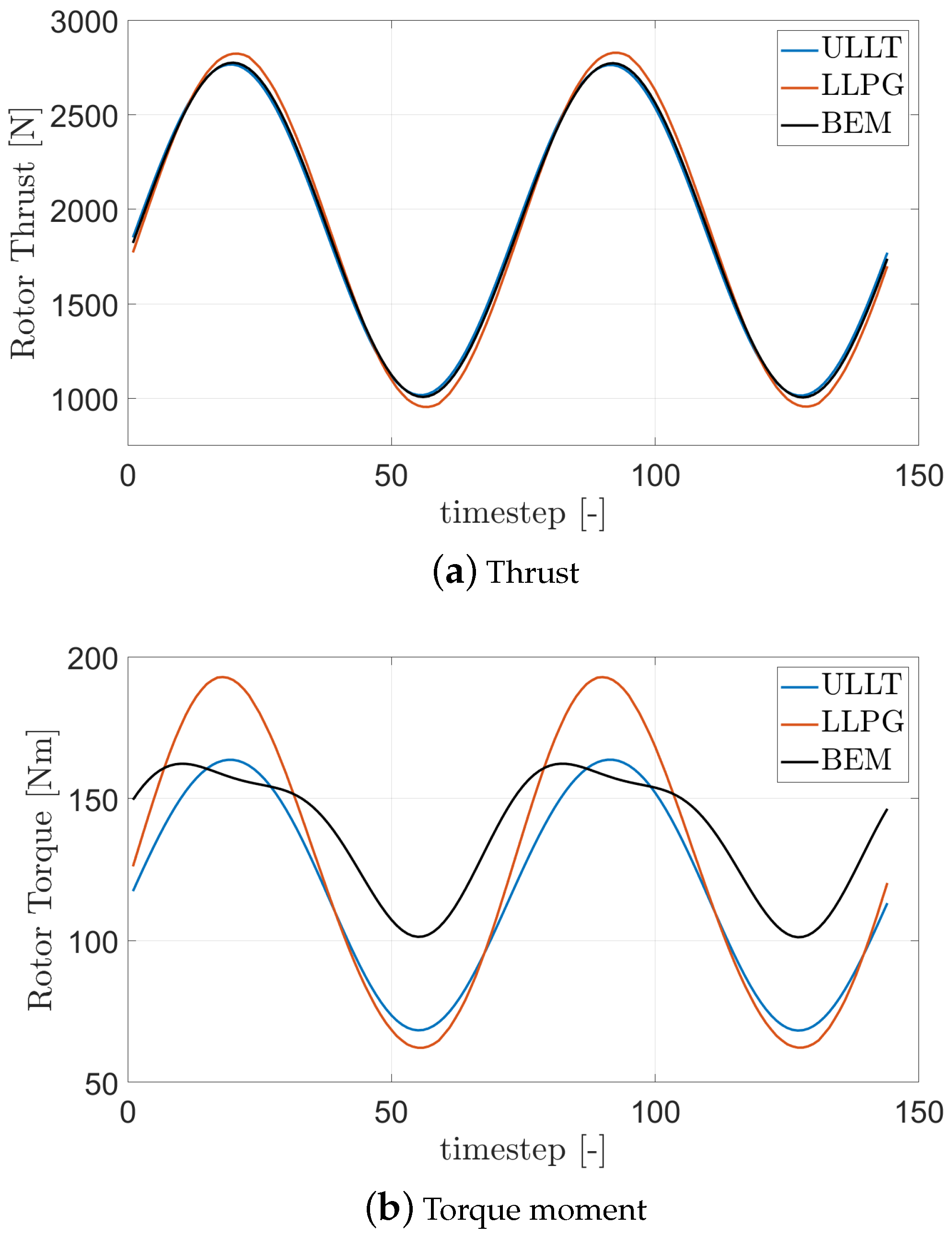
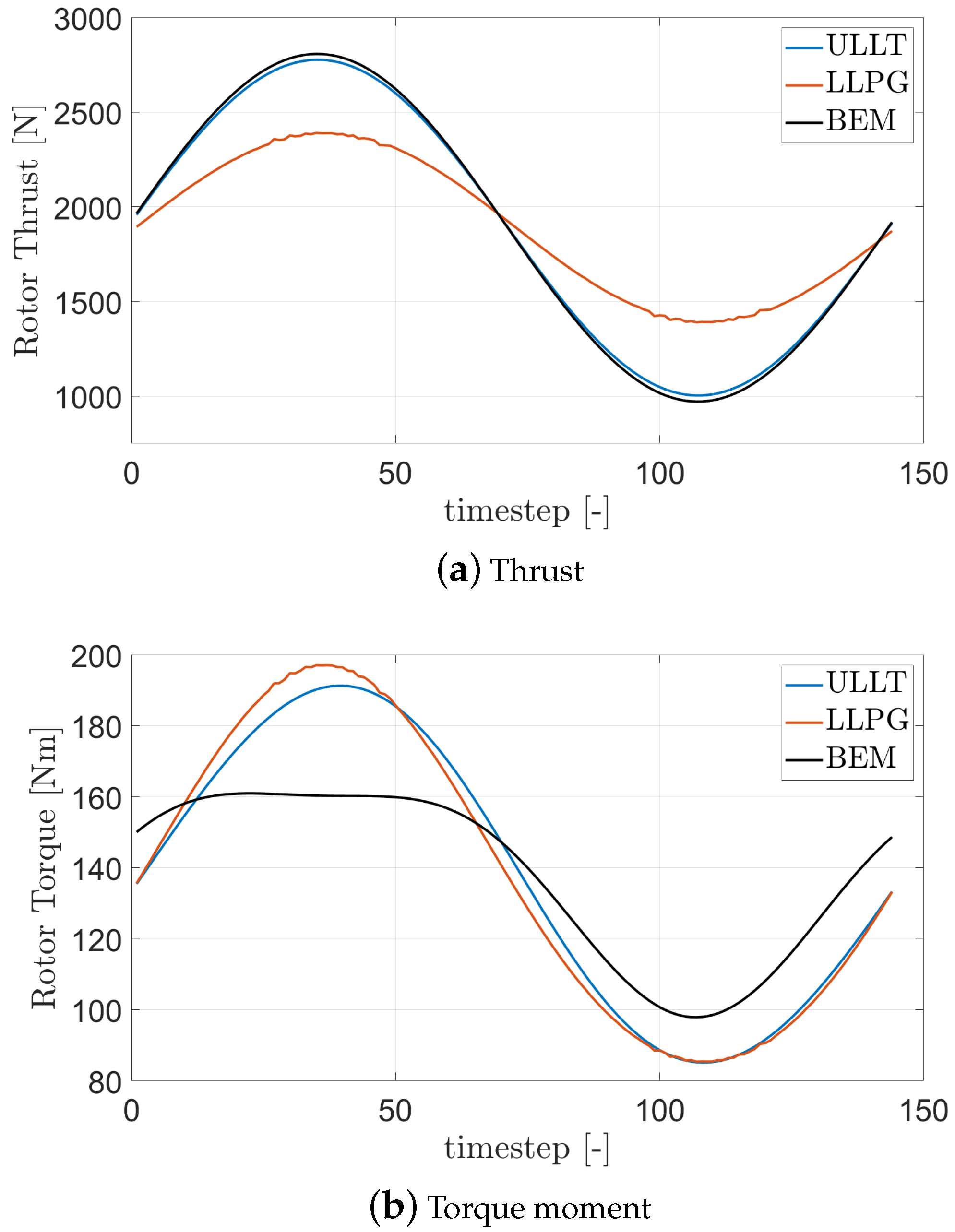
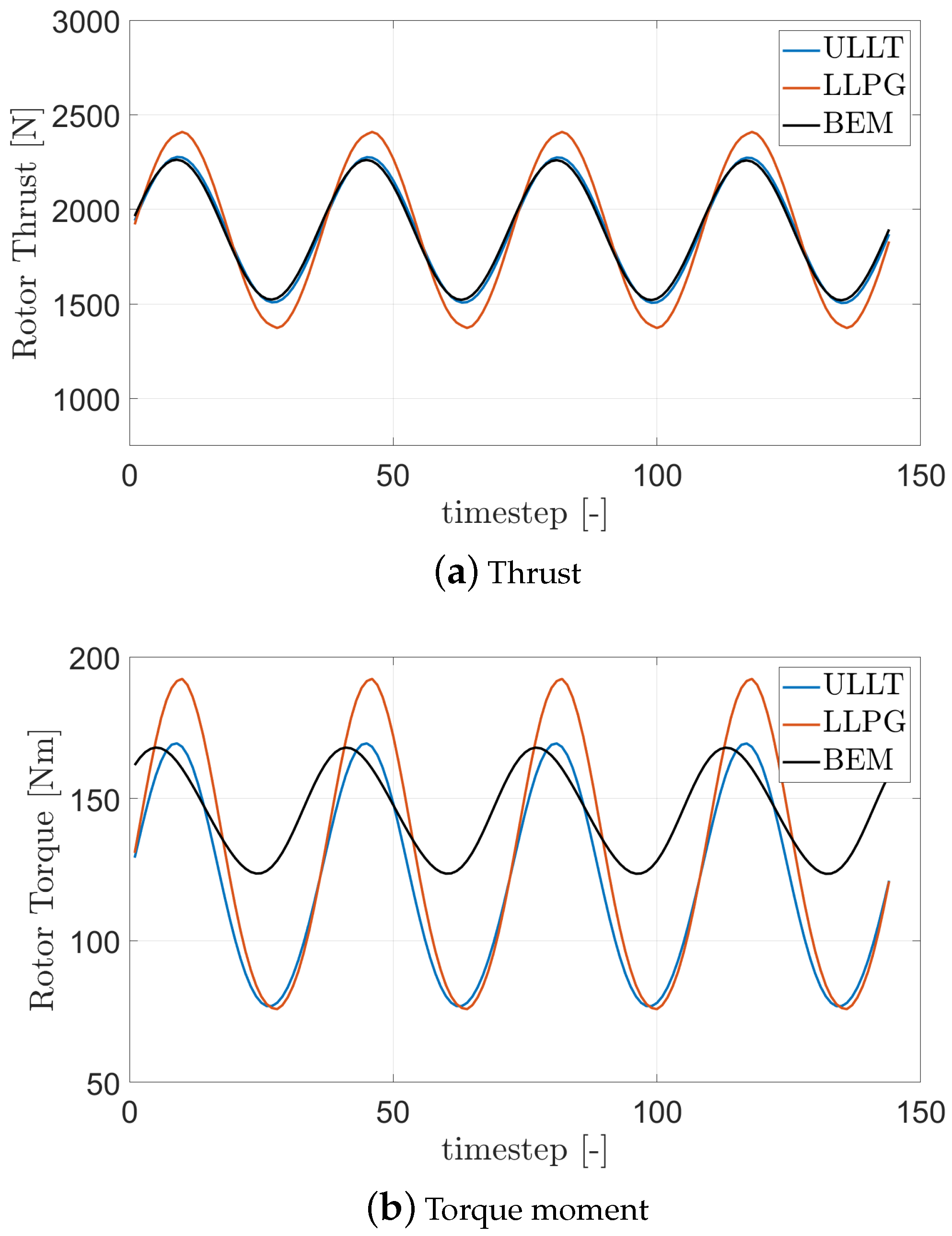
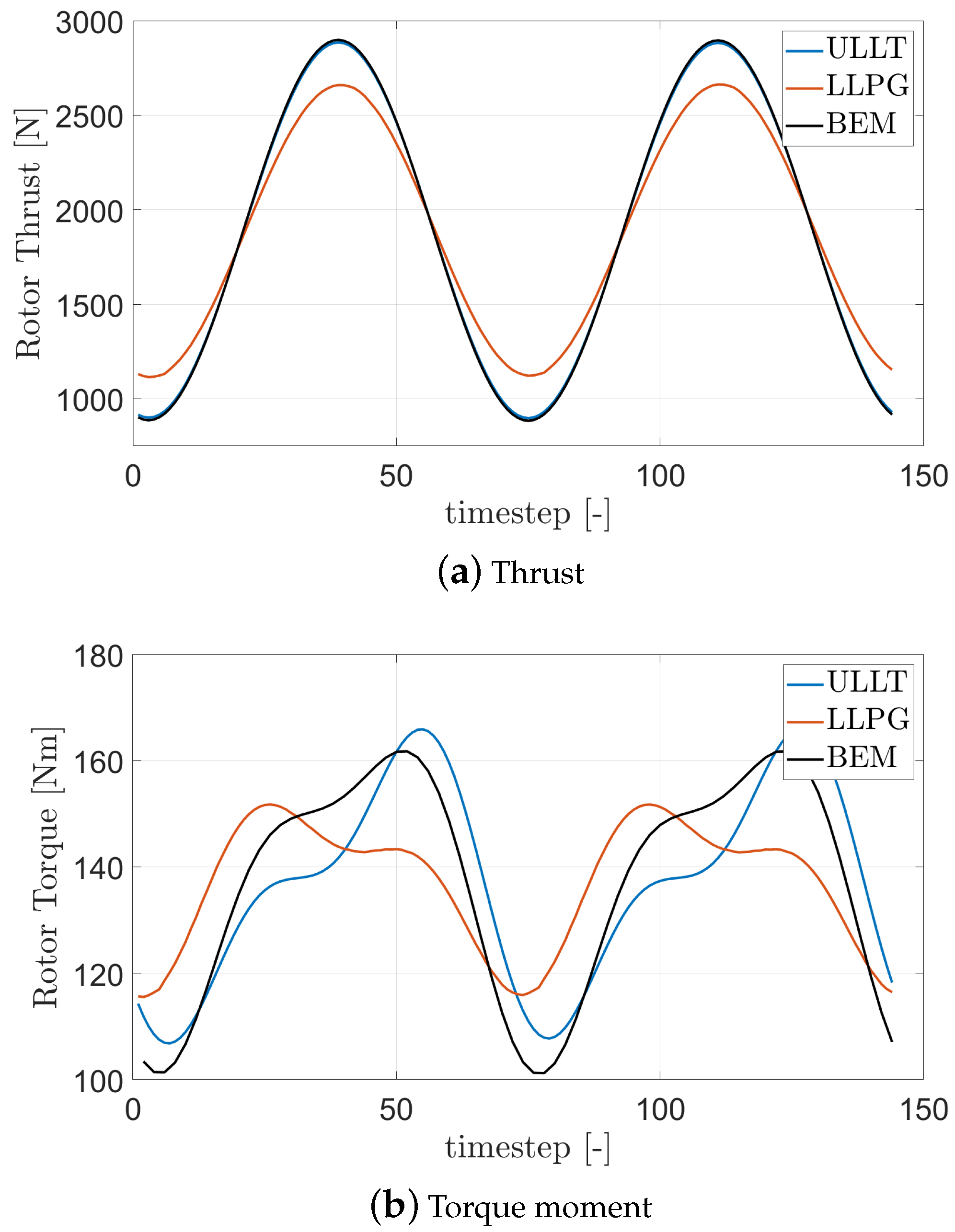


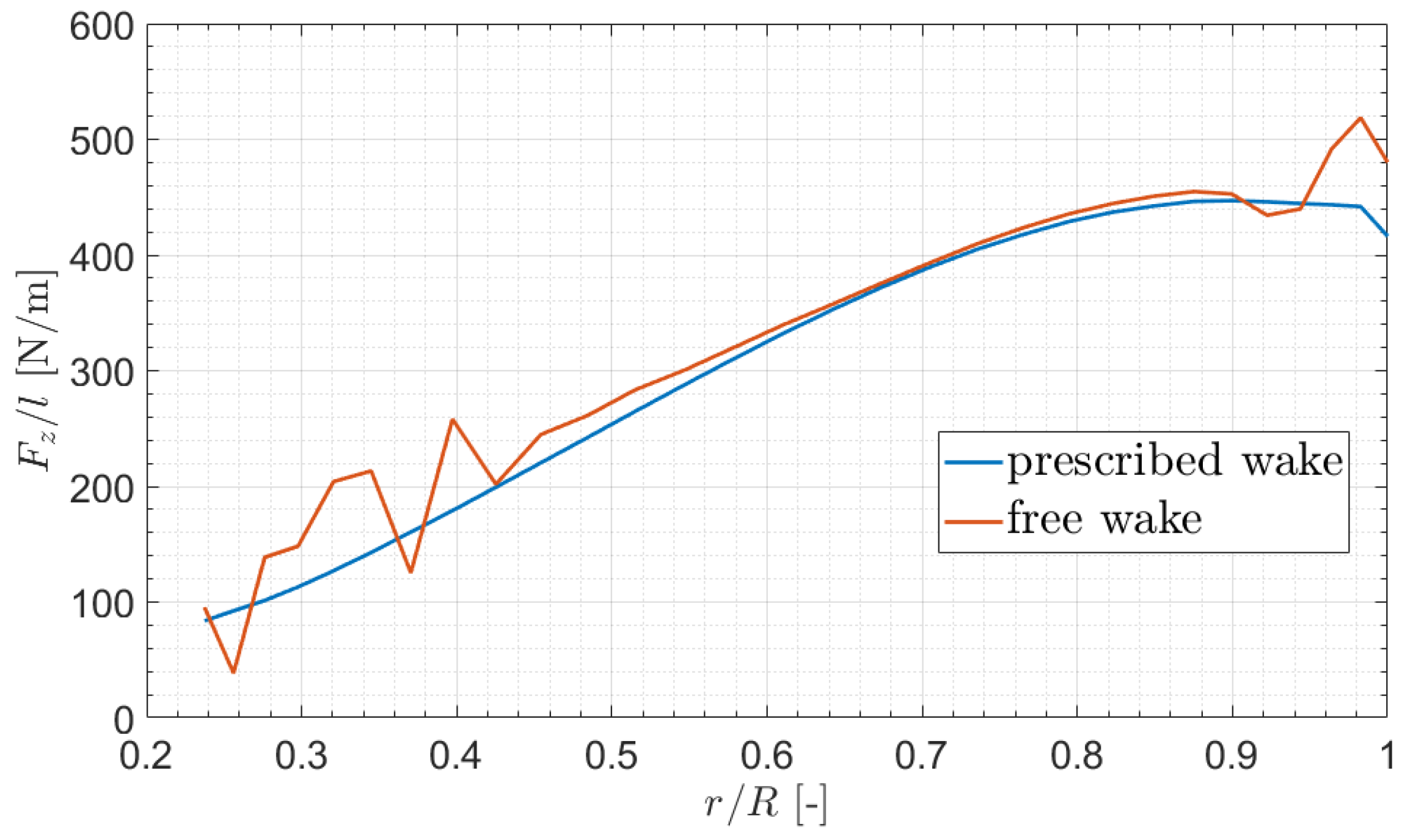
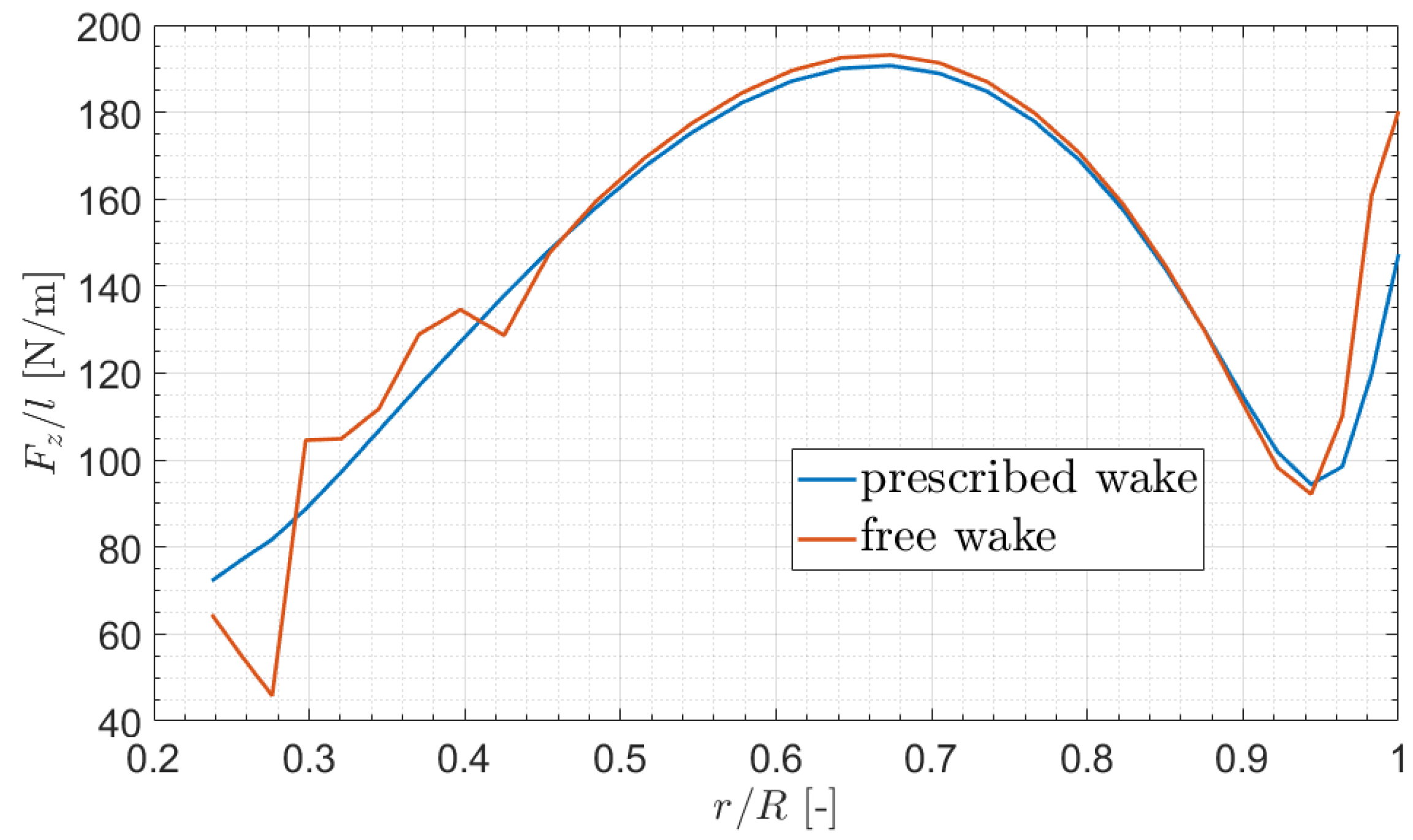
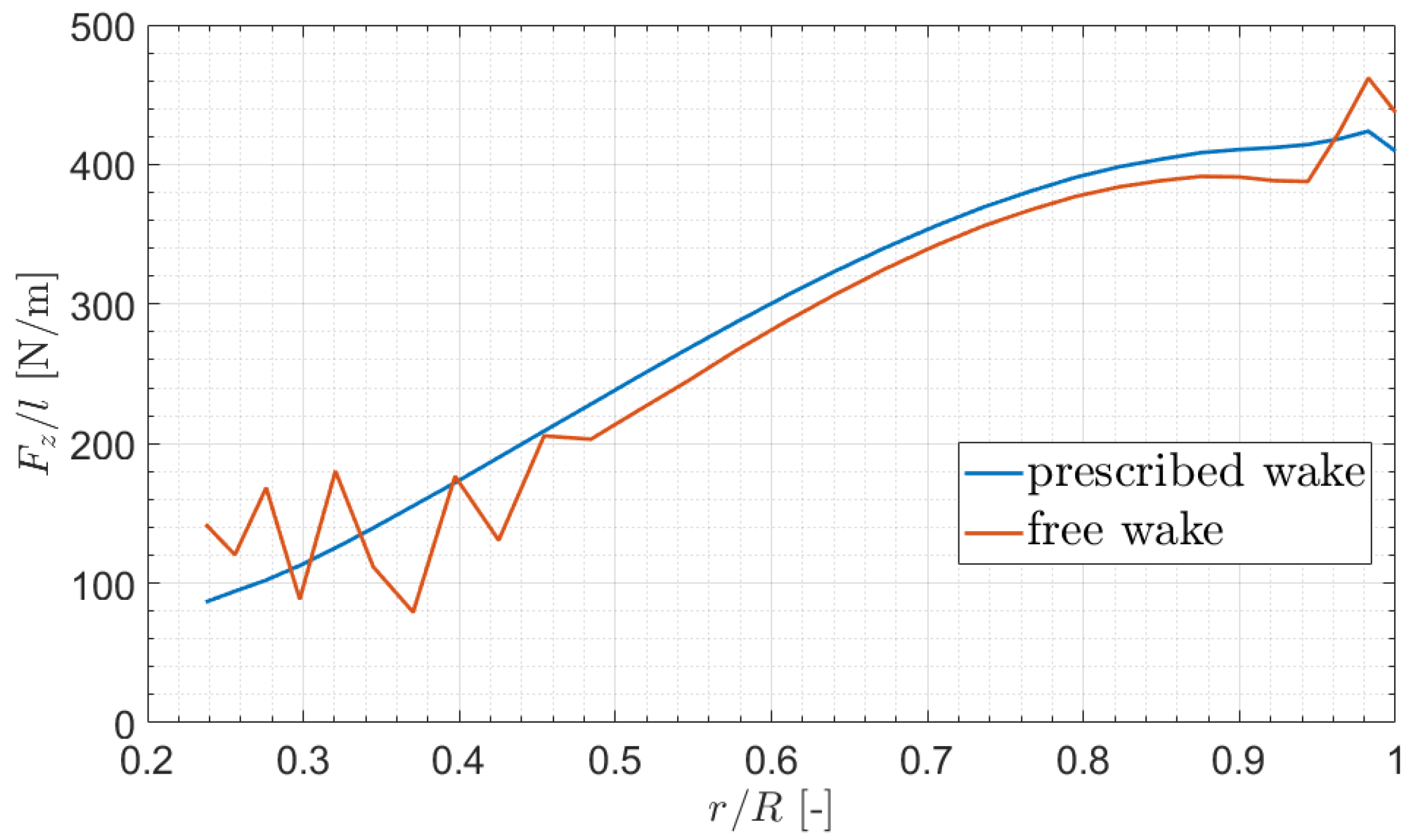
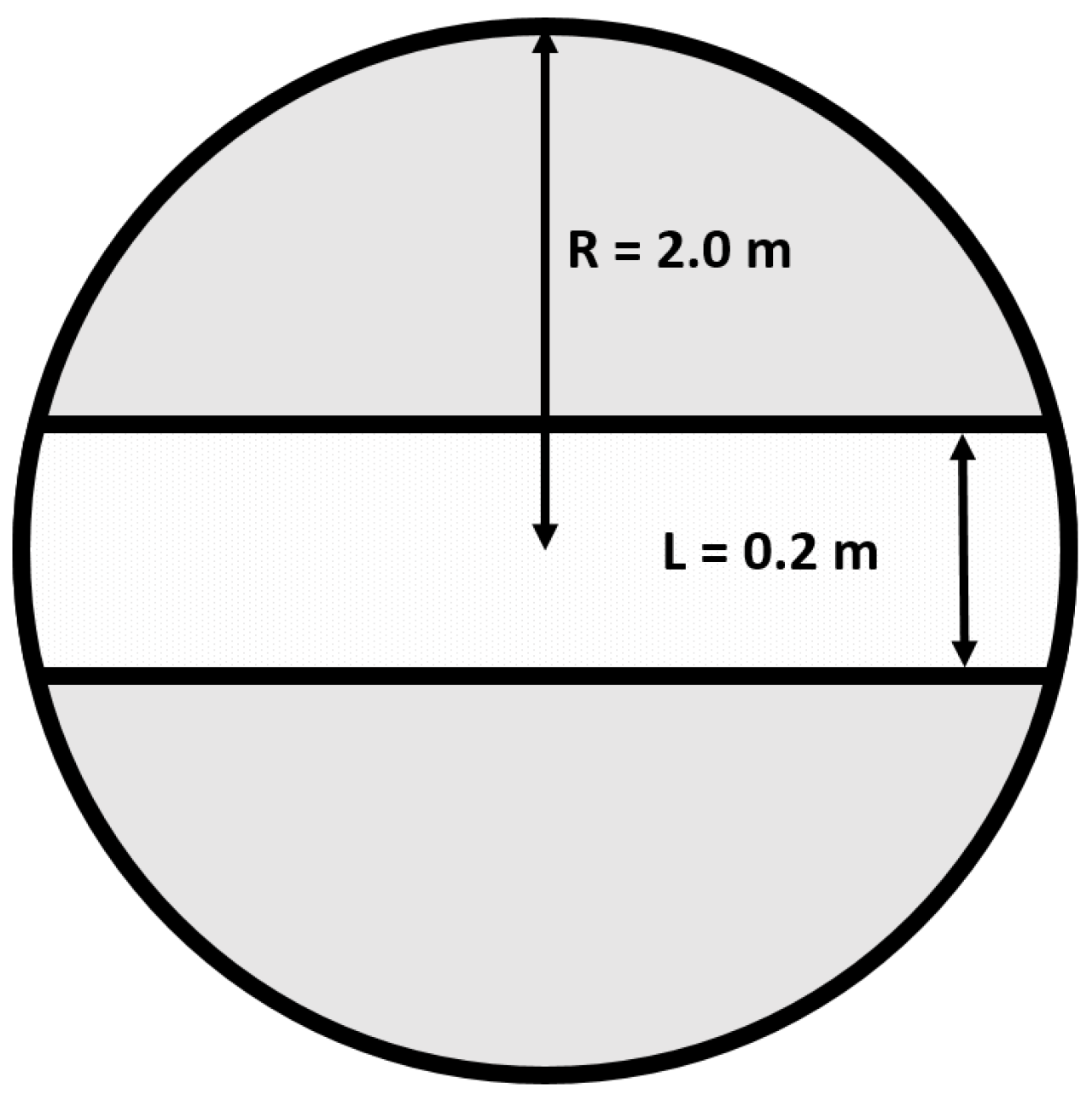
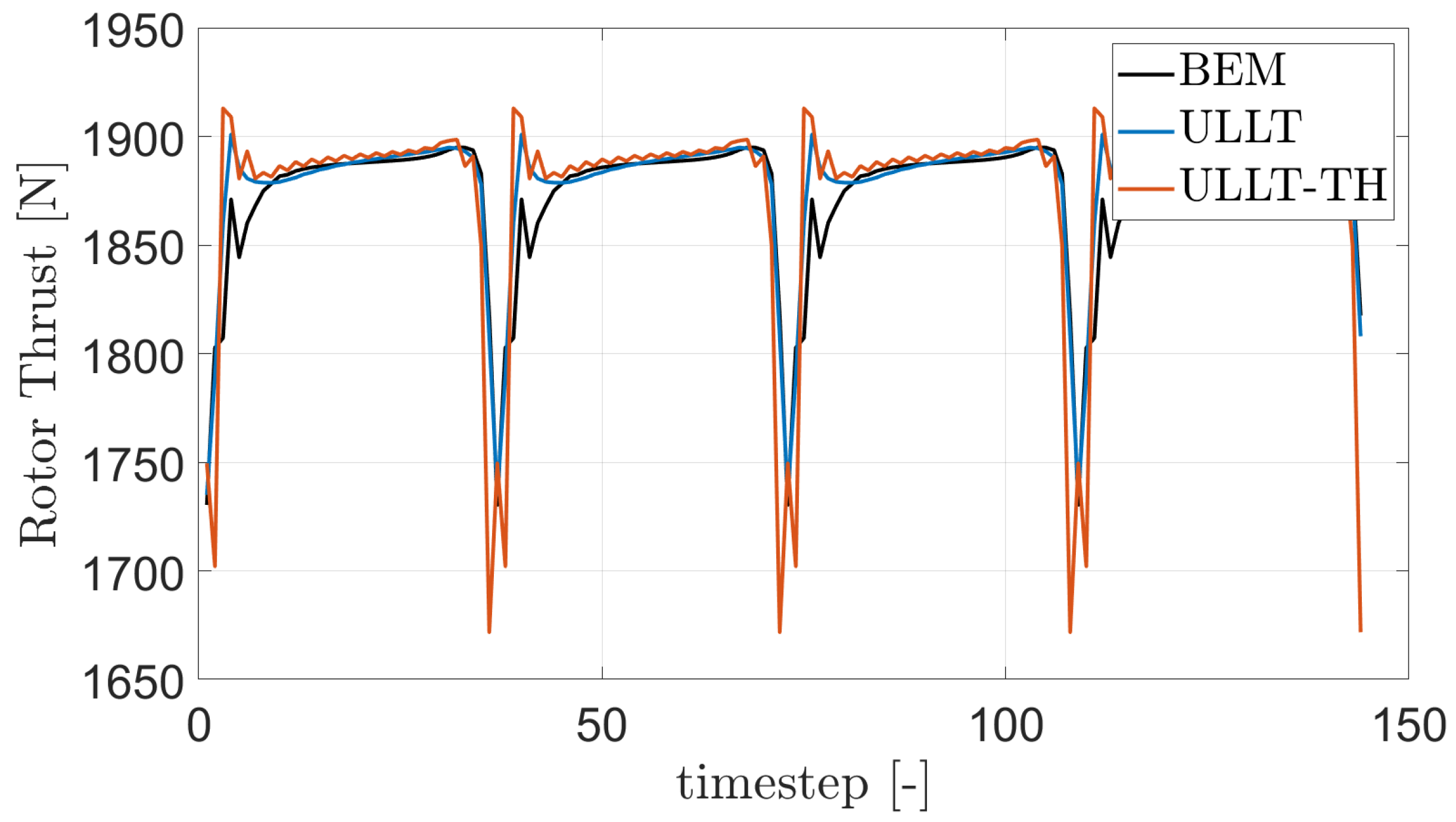
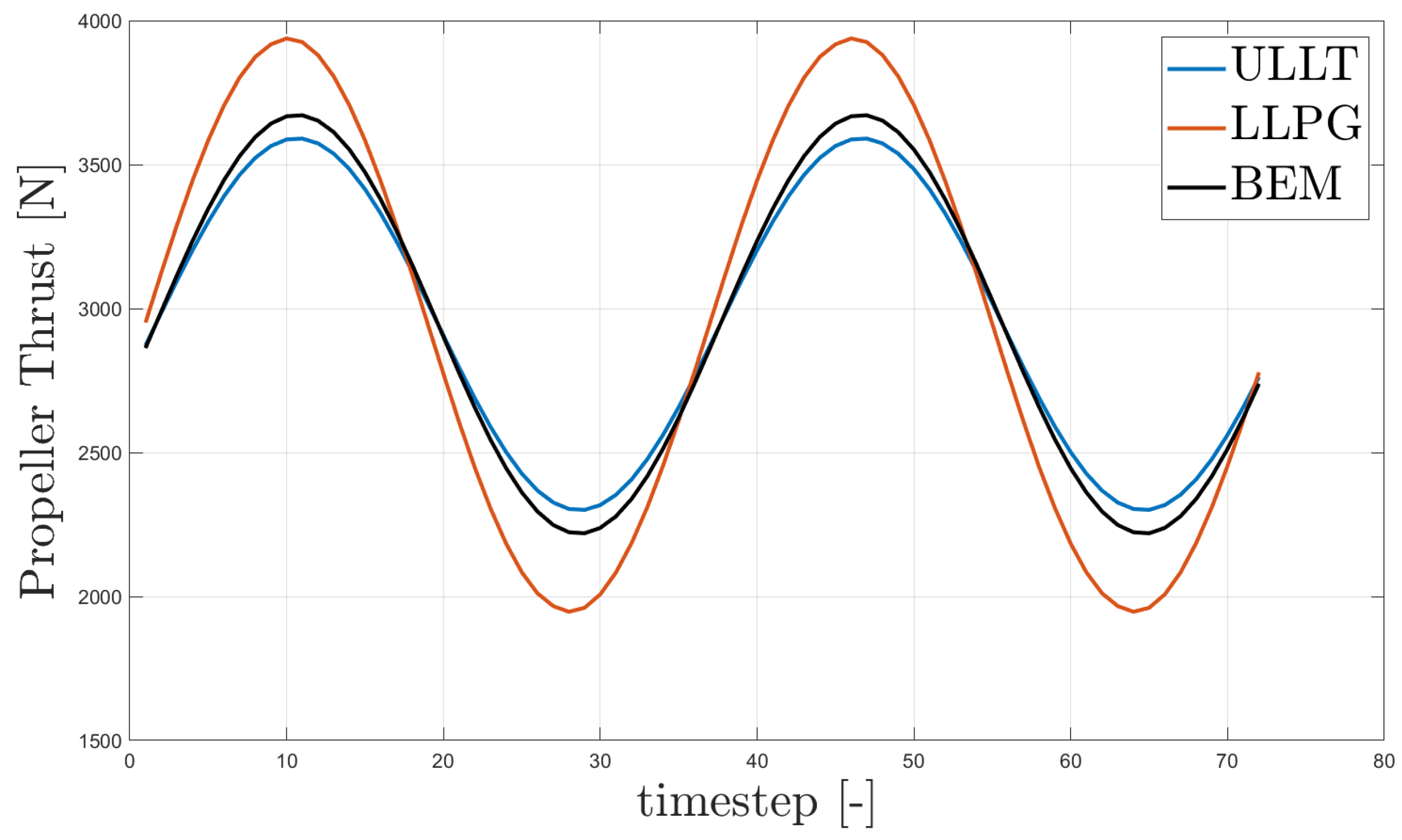
| Radius (R) | 2.0 m |
| Chord | 0.121 m |
| Twist Ratio () | –4.0 deg/m |
| Null Twist | @0.70R |
| Root Cutout | 0.22R |
| Section Airfoil | NACA23012 |
| Rotational Speed | 1041 RPM |
| Reference Collective Pitch () | 5.0 deg |
| N | BEM | ULLT |
|---|---|---|
| 5 | 10.0% | 8.5% |
| 6 | 7.1% | 2.5% |
| 7 | 4.9% | 2.3% |
| 8 | 3.2% | 1.0% |
| 9 | 1.9% | 0.3% |
| 10 | 0.8% | 0.2% |
| N | BEM | ULLT |
|---|---|---|
| 5 | 6.8% | 10.5% |
| 6 | 4.5% | 6.7% |
| 7 | 3.1% | 5.0% |
| 8 | 2.0% | 4.3% |
| 9 | 1.8% | 2.1% |
| 10 | 1.3% | 0.5% |
| Radius (R) | 3.6 m |
| Chord | 0.250 m |
| Twist Ratio () | –7.64 deg/m |
| Null Twist | @0.75R |
| Root Cutout | 0.25R |
| Section Airfoil | NACA0012 |
| Rotational Speed | 300 RPM |
| Cruise Speed | 200 keas |
| Reference Collective Pitch () | 55 deg |
Disclaimer/Publisher’s Note: The statements, opinions and data contained in all publications are solely those of the individual author(s) and contributor(s) and not of MDPI and/or the editor(s). MDPI and/or the editor(s) disclaim responsibility for any injury to people or property resulting from any ideas, methods, instructions or products referred to in the content. |
© 2025 by the authors. Licensee MDPI, Basel, Switzerland. This article is an open access article distributed under the terms and conditions of the Creative Commons Attribution (CC BY) license (https://creativecommons.org/licenses/by/4.0/).
Share and Cite
Frassoldati, G.; Giansante, R.; Bernardini, G.; Gennaretti, M. Unsteady Lifting-Line Free-Wake Aerodynamic Modeling for Rotors in Hovering and Axial Flight. Appl. Sci. 2025, 15, 12332. https://doi.org/10.3390/app152212332
Frassoldati G, Giansante R, Bernardini G, Gennaretti M. Unsteady Lifting-Line Free-Wake Aerodynamic Modeling for Rotors in Hovering and Axial Flight. Applied Sciences. 2025; 15(22):12332. https://doi.org/10.3390/app152212332
Chicago/Turabian StyleFrassoldati, Gregorio, Riccardo Giansante, Giovanni Bernardini, and Massimo Gennaretti. 2025. "Unsteady Lifting-Line Free-Wake Aerodynamic Modeling for Rotors in Hovering and Axial Flight" Applied Sciences 15, no. 22: 12332. https://doi.org/10.3390/app152212332
APA StyleFrassoldati, G., Giansante, R., Bernardini, G., & Gennaretti, M. (2025). Unsteady Lifting-Line Free-Wake Aerodynamic Modeling for Rotors in Hovering and Axial Flight. Applied Sciences, 15(22), 12332. https://doi.org/10.3390/app152212332







